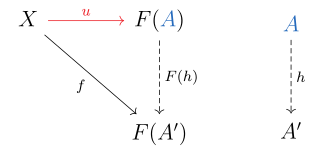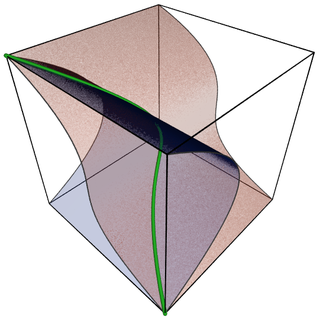
A bijection, bijective function, or one-to-one correspondence between two mathematical sets is a function such that each element of the second set is mapped to from exactly one element of the first set. Equivalently, a bijection is a relation between two sets such that each element of either set is paired with exactly one element of the other set.
In mathematics, especially in category theory and homotopy theory, a groupoid generalises the notion of group in several equivalent ways. A groupoid can be seen as a:

In the mathematical field of representation theory, group representations describe abstract groups in terms of bijective linear transformations of a vector space to itself ; in particular, they can be used to represent group elements as invertible matrices so that the group operation can be represented by matrix multiplication.
In algebra, a homomorphism is a structure-preserving map between two algebraic structures of the same type. The word homomorphism comes from the Ancient Greek language: ὁμός meaning "same" and μορφή meaning "form" or "shape". However, the word was apparently introduced to mathematics due to a (mis)translation of German ähnlich meaning "similar" to ὁμός meaning "same". The term "homomorphism" appeared as early as 1892, when it was attributed to the German mathematician Felix Klein (1849–1925).

In mathematics, more specifically in category theory, a universal property is a property that characterizes up to an isomorphism the result of some constructions. Thus, universal properties can be used for defining some objects independently from the method chosen for constructing them. For example, the definitions of the integers from the natural numbers, of the rational numbers from the integers, of the real numbers from the rational numbers, and of polynomial rings from the field of their coefficients can all be done in terms of universal properties. In particular, the concept of universal property allows a simple proof that all constructions of real numbers are equivalent: it suffices to prove that they satisfy the same universal property.
In category theory, a branch of mathematics, a natural transformation provides a way of transforming one functor into another while respecting the internal structure of the categories involved. Hence, a natural transformation can be considered to be a "morphism of functors". Informally, the notion of a natural transformation states that a particular map between functors can be done consistently over an entire category.
In mathematics, an embedding is one instance of some mathematical structure contained within another instance, such as a group that is a subgroup.
In category theory, an epimorphism is a morphism f : X → Y that is right-cancellative in the sense that, for all objects Z and all morphisms g1, g2: Y → Z,

Homological algebra is the branch of mathematics that studies homology in a general algebraic setting. It is a relatively young discipline, whose origins can be traced to investigations in combinatorial topology and abstract algebra at the end of the 19th century, chiefly by Henri Poincaré and David Hilbert.

Algebraic varieties are the central objects of study in algebraic geometry, a sub-field of mathematics. Classically, an algebraic variety is defined as the set of solutions of a system of polynomial equations over the real or complex numbers. Modern definitions generalize this concept in several different ways, while attempting to preserve the geometric intuition behind the original definition.
In mathematics, the idea of a free object is one of the basic concepts of abstract algebra. Informally, a free object over a set A can be thought of as being a "generic" algebraic structure over A: the only equations that hold between elements of the free object are those that follow from the defining axioms of the algebraic structure. Examples include free groups, tensor algebras, or free lattices.
In algebraic geometry, motives is a theory proposed by Alexander Grothendieck in the 1960s to unify the vast array of similarly behaved cohomology theories such as singular cohomology, de Rham cohomology, etale cohomology, and crystalline cohomology. Philosophically, a "motif" is the "cohomology essence" of a variety.
In mathematics, especially in the field of category theory, the concept of injective object is a generalization of the concept of injective module. This concept is important in cohomology, in homotopy theory and in the theory of model categories. The dual notion is that of a projective object.
In mathematics, the derived categoryD(A) of an abelian category A is a construction of homological algebra introduced to refine and in a certain sense to simplify the theory of derived functors defined on A. The construction proceeds on the basis that the objects of D(A) should be chain complexes in A, with two such chain complexes considered isomorphic when there is a chain map that induces an isomorphism on the level of homology of the chain complexes. Derived functors can then be defined for chain complexes, refining the concept of hypercohomology. The definitions lead to a significant simplification of formulas otherwise described (not completely faithfully) by complicated spectral sequences.
This is a glossary of properties and concepts in category theory in mathematics.
In algebraic geometry, an algebraic variety or scheme X is normal if it is normal at every point, meaning that the local ring at the point is an integrally closed domain. An affine variety X (understood to be irreducible) is normal if and only if the ring O(X) of regular functions on X is an integrally closed domain. A variety X over a field is normal if and only if every finite birational morphism from any variety Y to X is an isomorphism.
In model theory, a branch of mathematical logic, the Hrushovski construction generalizes the Fraïssé limit by working with a notion of strong substructure rather than . It can be thought of as a kind of "model-theoretic forcing", where a (usually) stable structure is created, called the generic or rich model. The specifics of determine various properties of the generic, with its geometric properties being of particular interest. It was initially used by Ehud Hrushovski to generate a stable structure with an "exotic" geometry, thereby refuting Zil'ber's Conjecture.
This is a glossary of algebraic geometry.
In mathematics, structural Ramsey theory is a categorical generalisation of Ramsey theory, rooted in the idea that many important results of Ramsey theory have "similar" logical structures. The key observation is noting that these Ramsey-type theorems can be expressed as the assertion that a certain category has the Ramsey property.
In mathematical logic, specifically in the discipline of model theory, the Fraïssé limit is a method used to construct (infinite) mathematical structures from their (finite) substructures. It is a special example of the more general concept of a direct limit in a category. The technique was developed in the 1950s by its namesake, French logician Roland Fraïssé.











